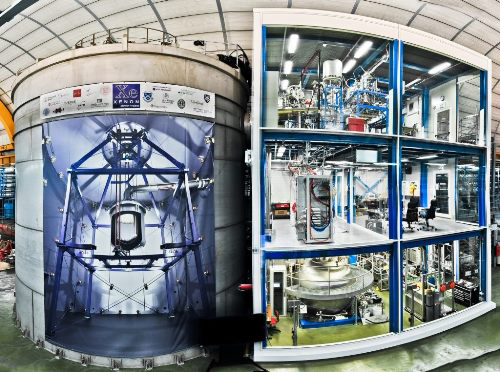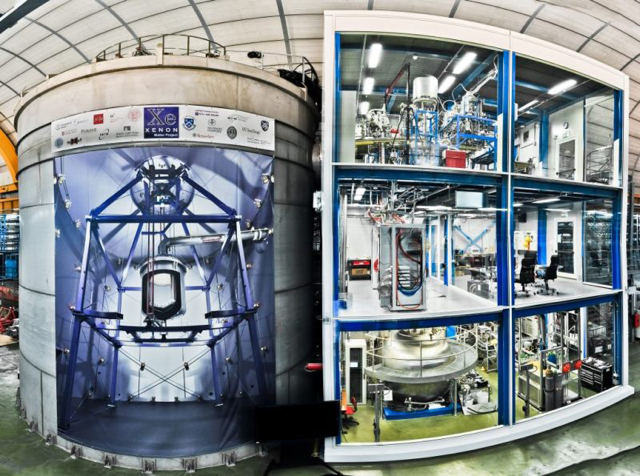The Relentless Hunt for Dark Matter
Dark matter does not emit, radiate, or absorb light, but most models predict that dark matter particles should—on rare occasions—interact with ordinary matter. Since the late 1980s, physicists have been deploying experiments deep underground in an effort to detect the gentle impacts of individual particles of dark matter. Over the past fifteen years or so, the collective sensitivity of these experiments has been increasing at an exponential rate, doubling each year or so on average. This staggering rate makes Moore’s Law seem stagnant in comparison.
Two independent experimental collaborations—XENON [1] and PandaX-II [2]—have recently taken the next steps in this relentless march of progress. The former group has built the world’s largest dark matter detector, called XENON1T. It utilizes a 2000-kg target of liquid xenon, housed in a 10-m-tall water tank located 1.4 km underground in the low-background environment of central Italy’s Gran Sasso National Laboratory (see Fig. 1). PandaX-II, by contrast, is located 2.4 km below ground in the China Jinping Underground Laboratory in Sichuan, China, and consists of 584 kg of liquid xenon. The reason both experiments use xenon is twofold. First, it is highly unreactive, helping to maintain the required low rate of background events. Second, its nucleus is relatively high in mass (containing 131 nucleons on average), providing a big target for incoming dark matter particles. If one of these particles were to pass through the Earth and then collide with a xenon nucleus in XENON1T or PandaX-II, that interaction could produce a faint but detectable signal of light (scintillation) and electric charge (ionization). Observing even a handful of such events would put us well on the way to identifying the nature of the mysterious substance that makes up our Universe’s dark matter. But even nondetections constitute progress, in that they reveal to us what the dark matter is not.
The recent publications from the XENON and PandaX-II collaborations do not claim to have detected any particles of dark matter, but the lack of such events can be used to place upper limits on the likelihood—or cross section—with which dark matter particles interact with ordinary matter. Because of the unprecedented size of these experiments, the reported limits are the most stringent to date on the dark matter’s proclivity to interact with nuclei. For a dark matter particle with a mass of 100 GeV, for example, each of these collaborations rule out cross sections for such interactions that are larger than about 10−46cm2 per nucleon. For comparison, this upper limit is millions of times smaller than the cross section predicted for a hypothetical 100-GeV neutrino interacting with a nucleus through the weak force. At higher masses, the limits presented by PandaX-II are slightly more stringent than those from XENON1T, while at lower masses the opposite is the case. And not too far behind these two is yet another limit, which was placed last year by the LUX experiment, located at the Sanford Underground Research Facility in South Dakota [3]. These three collaborations—representing the cutting edge in the search for dark matter— are in a race to build bigger and bigger detectors, with as low of a background as possible.
The lack of a definitive detection of dark matter particles, in both underground experiments and at the Large Hadron Collider [4–7], has had a palpable effect on the community of scientists that study particle dark matter. Even though a discovery could very plausibly be right around the corner, there is a widespread view that many of the most theoretically attractive candidates for dark matter should have been detected by now, based on their predicted properties. In the absence of such a discovery, the field has begun to redirect efforts toward new, and sometimes very different, ideas. Although this state of affairs can certainly be frustrating at times, it has also had the positive effect of ushering in an explosion in dark matter model building.
For example, a class of scenarios that has recently attracted a lot of attention is that in which the dark matter is but one of several particle species that make up a “hidden sector” [8]. Because hidden sector particles do not directly couple to ordinary particles, they can be very difficult to detect in underground experiments and hard to produce at accelerators. And at the same time, experimental progress is being made as well. Proposals for new and different kinds of experiments abound, with the goal of testing an ever wider range of previously overlooked candidates for dark matter.
Because of the progress of experiments such as XENON1T and PandaX-II, the field of dark matter research is currently in a state of major disruption. The dark matter, it turns out, is not what many of us in the particle theory community imagined it was likely to be. With this disruption, however, has come both great excitement and great opportunity. We know much more about dark matter’s nature than we did only a few short years ago. And the years ahead offer considerable promise for further advances, and perhaps with a little luck, the discovery that so many of us have been waiting for.
This research is published in Physical Review Letters.
References
- X. Cui et al. (PandaX-II Collaboration), “Dark Matter Results From 54-Ton-Day Exposure of PandaX-II Experiment,” Phys. Rev. Lett. 119, 181302 (2017).
- E. Aprile et al. (XENON Collaboration), “First Dark Matter Results from the XENON1T Experiment,” Phys. Rev. Lett. 119, 181301 (2017).
- D. S. Akerib et al. (LUX Collaboration), “Results from a Search for Dark Matter in the Complete LUX Exposure,” Phys. Rev. Lett. 118, 021303 (2017).
- G. Aad et al. (ATLAS Collaboration), “Search for Dark Matter in Events with a Z Boson and Missing Transverse Momentum in pp Collisions at √s=8 TeV with the ATLAS Detector,” Phys. Rev. D 90, 012004 (2014).
- G. Aad et al. (ATLAS Collaboration), “Search for Dark Matter in Events with Heavy Quarks and Missing Transverse Momentum in pp Collisions with the ATLAS Detector,” Eur. Phys. J. C 75, 92 (2015).
- V. Khachatryan et al. (CMS Collaboration), “Search for Dark Matter, Extra Dimensions, and Unparticles in Monojet Events in Proton-Proton Collisions at √s=8 TeV,” Eur. Phys. J. C 75, 235 (2015).
- A. M. Sirunyan et al. (CMS Collaboration), “Search for Dijet Resonances in Proton-Proton Collisions at √s=13 TeV and Constraints nn Dark Matter and Other Models,” Phys. Lett. B 769, 520 (2017); V. Khachatryan et al., “Corrigendum to “Search for dijet resonances in proton–proton collisions at √s=13 TeV and constraints on dark matter and other models” [Phys. Lett. B 769 (2017) 520–542],” 772, 882(E) (2017).
- M. Pospelov, A. Ritz, and M. Voloshin, “Secluded WIMP Dark Matter,” Phys. Lett. B 662, 53 (2008).





